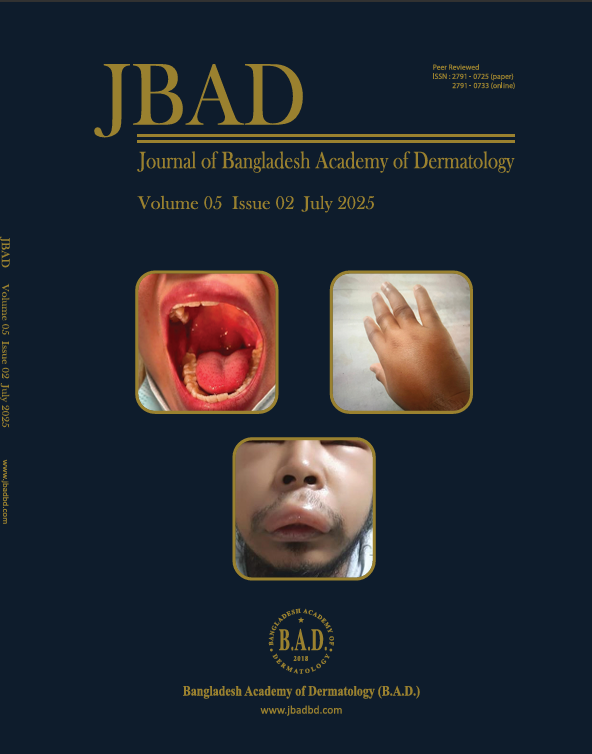Effect of Intralesional Triamcinolone Acetonide on Alopecia Areata
Abstract Background: Alopecia areata (AA) is a chronic, non-scarring autoimmune disorder characterized by patchy hair loss, significantly impacting patient quality of life. The lifetime prevalence of AA is approximately 1.7%, with substantial emotional and psychological implications. Objective: This study primarily sought to investigate the efficacy of two different concentrations of intralesional triamcinolone acetonide (ILT) in managing patchy scalp alopecia areata. Methodology: An open clinical trial was conducted at the National Institute of Diseases of the Chest and Hospital, Dhaka Bangladesh, from January 2023 to June 2024. The study enrolled 55 patients with patchy alopecia areata involving less than 50% of scalp surface area. Participants were systematically divided into two treatment groups: Group A (n=27) received intralesional triamcinolone acetonide at 5 mg/mL, while Group B (n=28) received 10 mg/mL concentration. Patients underwent monthly intralesional injections, with comprehensive assessments performed at 12 weeks and a one-year follow-up to evaluate treatment response and potential recurrence. Results: The two concentration groups' treatment outcomes were identical. After 12 weeks, 44.4% of patients in the 5 mg/mL group and 42.9% in the 10 mg/mL group experienced complete hair regrowth, with 63.0% and 64.3% of patients reporting satisfactory overall results, respectively. With no documented cases of hypopigmentation, the side effect profiles were mild and similar, mainly manifesting as folliculitis (3.7% vs. 3.6%), telangiectasia with atrophy (3.7% vs. 10.7%), and localized atrophy (11.1% in the 5 mg/mL group vs. 10.7% in the 10 mg/mL group). The chronic nature of alopecia areata was demonstrated by the recurrence rates during follow-up, which were 50.4% for the 10 mg/mL group and 44.4% for the 5 mg/mL group. This study emphasizes the similar effectiveness of intralesional triamcinolone acetonide at both concentrations, giving physicians options for treatment choices. It also emphasizes the significance of early intervention and all-encompassing patient care. Conclusions: Intralesional triamcinolone acetonide represents a valuable treatment modality for localized alopecia areata. While demonstrating significant potential for hair regrowth, the study also revealed the challenges associated with long-term management, characterized by relatively high recurrence rates. Keywords: Intralesional triamcinolone acetonide, Alopecia areata, Scalp hair regrowth, Steroid injection therapy, Autoimmune hair loss, Treatment concentration efficacy. |

